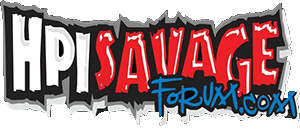As the subject says, this is my first custom body. I am totally new to airbrushing, and had never seen or touched one before yesterday. Luckily my sister was on hand to help me with the basics.
I went for the Dodge body to practice on, as I wanted to leave the HPI stock body until I got a little more confident!
I played around with some graphics on the computer and printed them off onto acetate, then transferred them onto sticky plastic. I then came to the conclusion that it would be a lot easier to just buy the pre-cut sticky plastic masks, so I picked 5 or 6 and decided what I was going to use when they arrived.
It took a little while to get everything sorted out. I read through shifts tutorial a couple of times and used the water/soap and sanding method before applying my first coat of paint. I messed up a little with the first masking that I applied, as the border came off. After the first I used a hairdryer to shrink the top plastic layer so it peeled off easier and left the masking in place.
I used Pactra paints throughout, they were pretty easy to mix and thin and applied really nice at low psi. Unfortunately my LHS has a lot of the colours I ordered on backorder, so I just went with what I had which was metallic black, racing green, yellow and some thinner. Not a great amount to choose from, but I think it turned out well!
Anyhoo, here are some pictures along the way. I have loads, so just ask if you would like to see any others.




I have learnt a lot, so hopefully my next attempt will be a lot smoother and will look a lot better!
Let me know what you think =) ..oh and I had just brought my savvy back from a bashing session, so I hadn't cleaned it off.. it was just my model for the photo shoot!!
I went for the Dodge body to practice on, as I wanted to leave the HPI stock body until I got a little more confident!
I played around with some graphics on the computer and printed them off onto acetate, then transferred them onto sticky plastic. I then came to the conclusion that it would be a lot easier to just buy the pre-cut sticky plastic masks, so I picked 5 or 6 and decided what I was going to use when they arrived.
It took a little while to get everything sorted out. I read through shifts tutorial a couple of times and used the water/soap and sanding method before applying my first coat of paint. I messed up a little with the first masking that I applied, as the border came off. After the first I used a hairdryer to shrink the top plastic layer so it peeled off easier and left the masking in place.
I used Pactra paints throughout, they were pretty easy to mix and thin and applied really nice at low psi. Unfortunately my LHS has a lot of the colours I ordered on backorder, so I just went with what I had which was metallic black, racing green, yellow and some thinner. Not a great amount to choose from, but I think it turned out well!
Anyhoo, here are some pictures along the way. I have loads, so just ask if you would like to see any others.
I have learnt a lot, so hopefully my next attempt will be a lot smoother and will look a lot better!
Let me know what you think =) ..oh and I had just brought my savvy back from a bashing session, so I hadn't cleaned it off.. it was just my model for the photo shoot!!
